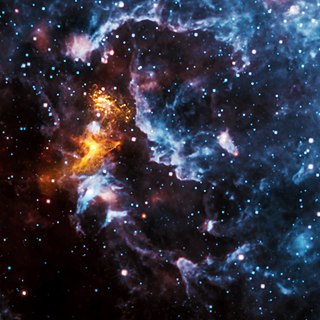High energy astronomy is the study of astronomical objects that release electromagnetic radiation of highly energetic wavelengths. It includes X-ray astronomy, gamma-ray astronomy, extreme UV astronomy, neutrino astronomy, and studies of cosmic rays. The physical study of these phenomena is referred to as high-energy astrophysics.

A magnetar is a type of neutron star with an extremely powerful magnetic field (∼109 to 1011 T, ∼1013 to 1015 G). The magnetic-field decay powers the emission of high-energy electromagnetic radiation, particularly X-rays and gamma rays.

XMM-Newton, also known as the High Throughput X-ray Spectroscopy Mission and the X-ray Multi-Mirror Mission, is an X-ray space observatory launched by the European Space Agency in December 1999 on an Ariane 5 rocket. It is the second cornerstone mission of ESA's Horizon 2000 programme. Named after physicist and astronomer Sir Isaac Newton, the spacecraft is tasked with investigating interstellar X-ray sources, performing narrow- and broad-range spectroscopy, and performing the first simultaneous imaging of objects in both X-ray and optical wavelengths.

The Fermi Gamma-ray Space Telescope, formerly called the Gamma-ray Large Area Space Telescope (GLAST), is a space observatory being used to perform gamma-ray astronomy observations from low Earth orbit. Its main instrument is the Large Area Telescope (LAT), with which astronomers mostly intend to perform an all-sky survey studying astrophysical and cosmological phenomena such as active galactic nuclei, pulsars, other high-energy sources and dark matter. Another instrument aboard Fermi, the Gamma-ray Burst Monitor, is being used to study gamma-ray bursts and solar flares.
The Max Planck Institute for Extraterrestrial Physics is a Max Planck Institute, located in Garching, near Munich, Germany. In 1991 the Max Planck Institute for Physics and Astrophysics split up into the Max Planck Institute for Extraterrestrial Physics, the Max Planck Institute for Physics and the Max Planck Institute for Astrophysics. The Max Planck Institute for Extraterrestrial Physics was founded as sub-institute in 1963. The scientific activities of the institute are mostly devoted to astrophysics with telescopes orbiting in space. A large amount of the resources are spent for studying black holes in the galaxy and in the remote universe.

Neil Gehrels Swift Observatory, previously called the Swift Gamma-Ray Burst Explorer, is a NASA three-telescope space observatory for studying gamma-ray bursts (GRBs) and monitoring the afterglow in X-ray, and UV/Visible light at the location of a burst. It was launched on 20 November 2004, aboard a Delta II launch vehicle. Headed by principal investigator Neil Gehrels until his death in February 2017, the mission was developed in a joint partnership between Goddard Space Flight Center (GSFC) and an international consortium from the United States, United Kingdom, and Italy. The mission is operated by Pennsylvania State University as part of NASA's Medium Explorer program (MIDEX).

A pulsar is a highly magnetized rotating neutron star that emits beams of electromagnetic radiation out of its magnetic poles. This radiation can be observed only when a beam of emission is pointing toward Earth, and is responsible for the pulsed appearance of emission. Neutron stars are very dense and have short, regular rotational periods. This produces a very precise interval between pulses that ranges from milliseconds to seconds for an individual pulsar. Pulsars are one of the candidates for the source of ultra-high-energy cosmic rays.

The INTErnational Gamma-Ray Astrophysics Laboratory (INTEGRAL) is a space telescope for observing gamma rays of energies up to 8 MeV. It was launched by the European Space Agency (ESA) into Earth orbit in 2002, and is designed to provide imaging and spectroscopy of cosmic sources. In the MeV energy range, it is the most sensitive gamma ray observatory in space. It is sensitive to higher energy photons than X-ray instruments such as NuSTAR, the Neil Gehrels SWIFT Observatory, XMM-Newton, and lower than other gamma-ray instruments such Fermi and HESS.

Geminga is a gamma ray and x-ray pulsar source thought to be a neutron star approximately 250 parsecs from the Sun in the constellation Gemini.

The Vela Pulsar is a radio, optical, X-ray- and gamma-emitting pulsar associated with the Vela Supernova Remnant in the constellation of Vela. Its parent Type II supernova exploded approximately 11,000–12,300 years ago.

NASA's Education and Public Outreach (E/PO) group at Sonoma State University, founded in 1999, is a provider of educational materials for students, educators, scientists, and the public. Funded by NASA and the United States Department of Education, employees work together to create educational guides, fact sheets, worksheets, posters, games, and informational websites. Most of these educational materials are related to the four major missions that support the group: Fermi Gamma-ray Space Telescope, Swift Gamma-Ray Burst Mission, XMM-Newton, and NuSTAR.

Cornelis A. "Neil" Gehrels was an American astrophysicist specializing in the field of gamma-ray astronomy. He was Chief of the Astroparticle Physics Laboratory at NASA's Goddard Space Flight Center (GSFC) from 1995 until his death, and was best known for his work developing the field from early balloon instruments to today's space observatories such as the NASA Swift mission, for which he was the Principal investigator. He was leading the WFIRST wide-field infrared telescope forward toward a launch in the mid-2020s. He was a member of the National Academy of Sciences and the American Academy of Arts and Sciences.

Gamma-ray astronomy is the astronomical observation of gamma rays, the most energetic form of electromagnetic radiation, with photon energies above 100 keV. Radiation below 100 keV is classified as X-rays and is the subject of X-ray astronomy.

PSR J1311–3430 is a pulsar with a spin period of 2.5 milliseconds. It is the first millisecond pulsar found via gamma-ray pulsations. The source was originally identified by the Energetic Gamma Ray Experiment Telescope as a bright gamma ray source, but was not recognized as a pulsar until observations with the Fermi Gamma-ray Space Telescope discovered pulsed gamma ray emission. The pulsar has a helium-dominated companion much less massive than itself, and the two are in an orbit with a period of 93.8 minutes. The system is explained by a model where mass from the low mass companion was transferred on to the pulsar, increasing the mass of the pulsar and decreasing its period. These systems are known as Black Widow Pulsars, named after the original such system discovered, PSR B1957+20, and may eventually lead to the companion being completely vaporized. Among systems like these, the orbital period of PSR J1311–3430 is the shortest ever found. Spectroscopic observations of the companion suggest that the mass of the pulsar is 2.7 . Though there is considerable uncertainty in this estimate, the minimum mass for the pulsar that the authors find adequately fits the data is 2.15 , which is still more massive than PSR J1614−2230, the previous record holder for most massive known pulsar.

The Neutron Star Interior Composition ExploreR (NICER) is a NASA telescope on the International Space Station, designed and dedicated to the study of the extraordinary gravitational, electromagnetic, and nuclear physics environments embodied by neutron stars, exploring the exotic states of matter where density and pressure are higher than in atomic nuclei. As part of NASA's Explorer program, NICER enabled rotation-resolved spectroscopy of the thermal and non-thermal emissions of neutron stars in the soft X-ray band with unprecedented sensitivity, probing interior structure, the origins of dynamic phenomena, and the mechanisms that underlie the most powerful cosmic particle accelerators known. NICER achieved these goals by deploying, following the launch, and activation of X-ray timing and spectroscopy instruments. NICER was selected by NASA to proceed to formulation phase in April 2013.

Giovanni Fabrizio Bignami was an Italian physicist. From March 2007 until August 2008, he was Chairman of the Italian Space Agency. Between 2010 and 2014, he was the first Italian to chair the Committee on Space Research (COSPAR), and from 2011 until 2015, he was President of INAF. He was also the chairman of the SKA project. He was married to fellow Italian astrophysicist Patrizia A. Caraveo.
Lynn Cominsky is an American astrophysicist and educator. She is currently the Chair of Astronomy and Physics at Sonoma State University in Rohnert Park, California, as well as the Project Director for the NASA Education and Public Outreach Group.

Eleonora Troja is an Italian astrophysicist. In 2017 she led the discovery of X-ray emission from the gravitational wave source GW170817.

PSR J0952–0607 is a massive millisecond pulsar in a binary system, located between 3,200–5,700 light-years (970–1,740 pc) away from Earth in the constellation Sextans. It holds the record for being the most massive neutron star known as of 2022, with a mass 2.35±0.17 times as much as the Sun—potentially close to the Tolman–Oppenheimer–Volkoff mass upper limit for neutron stars. The pulsar rotates at a frequency of 707 Hz, making it the second-fastest-spinning pulsar known, and the fastest-spinning pulsar that is located in the Milky Way.
















